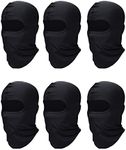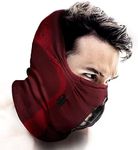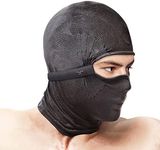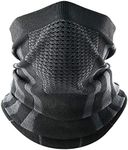Buying Guide for the Best Ski Masks
Choosing the right ski mask is essential for ensuring comfort, protection, and performance on the slopes. A good ski mask will protect your face from harsh weather conditions, keep you warm, and provide a clear field of vision. When selecting a ski mask, consider the following key specifications to find the best fit for your needs.MaterialThe material of a ski mask is crucial because it determines the mask's warmth, breathability, and comfort. Common materials include fleece, wool, and synthetic fabrics like polyester or spandex blends. Fleece is warm and soft, making it ideal for very cold conditions. Wool is naturally insulating and moisture-wicking, which is great for variable weather. Synthetic fabrics are often lightweight, stretchy, and quick-drying, suitable for active skiers. Choose a material based on the typical weather conditions you'll be skiing in and your personal comfort preferences.
BreathabilityBreathability refers to how well the ski mask allows moisture and sweat to escape. This is important to prevent your face from becoming damp and cold. Masks with good breathability often have mesh panels or are made from moisture-wicking materials. If you tend to ski vigorously or in warmer conditions, look for a mask with high breathability to stay comfortable and dry. For colder, less intense skiing, breathability is still important but can be balanced with warmth.
Fit and ComfortA well-fitting ski mask should cover your face snugly without being too tight or restrictive. It should stay in place during movement and fit comfortably under your helmet or goggles. Look for masks with adjustable features like drawstrings or elastic bands to customize the fit. Try on different styles to see which one feels best on your face, ensuring it doesn't cause pressure points or discomfort during extended wear.
CoverageCoverage refers to how much of your face and neck the ski mask protects. Some masks cover just the lower face and neck, while others provide full coverage, including the head. Full-coverage masks are ideal for extremely cold or windy conditions, offering maximum protection. Partial coverage masks are more versatile and can be paired with other gear like hats or neck gaiters. Consider the typical weather conditions and your personal preference for coverage when choosing a mask.
VentilationVentilation features, such as breathing holes or mesh panels, help prevent fogging of goggles and allow for easier breathing. This is particularly important if you wear glasses or goggles, as fogging can impair your vision. Masks with good ventilation are essential for maintaining clear vision and comfort, especially during intense physical activity. If you often experience fogging issues, prioritize masks with effective ventilation systems.
Wind and Water ResistanceWind and water resistance are important for keeping your face dry and warm in harsh weather conditions. Masks with windproof and waterproof properties provide better protection against the elements. Look for masks with a durable water-repellent (DWR) coating or windproof materials if you frequently ski in wet or windy environments. For milder conditions, these features may be less critical, but they can still enhance overall comfort and protection.
Style and DesignWhile functionality is key, the style and design of a ski mask can also be important for personal preference and aesthetics. Ski masks come in various colors, patterns, and designs, allowing you to express your style on the slopes. Additionally, some designs may offer specific features like detachable face covers or convertible styles. Choose a design that you find appealing and that meets your functional needs.























